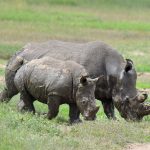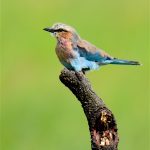Blog post by ‘Team Room Geckos’ – Hannah, Chloe, Danya
To start our day off, we had a lovely breakfast of eggs, plantains and fruit prepared by our chef Chenzen and John. Afterwards we headed to Ol Pejeta Conservancy in our magic safari bus. Once inside the gates, our first stop was the Sweetwaters Chimpanzee Sanctuary founded by Jane Goodall in 1993. The sanctuary is home to over 20 chimps that were rescued from different situations all across Africa. We met two chimpanzees by the names of Max and Poko, who thought it was hilarious to watch our reactions as they threw dirt and poop at us! Though this may not have been our preferred way of interacting with our closest living relatives we were still able to appreciate their intelligence, and ability to produce ammo on demand. The next stop on our tour was the blind, black rhino named Baraka, who is housed in a separate area within the conservancy. Baraka lost his sight as a result of fighting with other males and had to be taken to his own separate enclosure so that he wouldn’t be killed by other rhinos in the wild. Lucky for us, he is used to human interaction and we were able to hand-feed him sugar canes (his favourite treat) as well as pet him. As we emerged from the bush, we were greeted with an outdoor picnic. Thanks to the staff at Bunduz, we were able to enjoy lunch while the park and its many wild inhabitants served as the perfect backdrop.
We then embarked on our second game drive of the trip! A look out the window in any direction offered the perfect view of the beloved grassland landscape that comes to mind when one thinks of Africa. Everywhere we looked there was something new and at times we found ourselves conflicted as to which species to look at first. Unfortunately, we forgot our catnip today for the lions, but we still got to see three of Kenya’s “Big 5” being Cape Buffalo, White Rhino and Bush Elephant. A definite favourite were the memories (herds) of elephants each being just as majestic as the last! We noticed that female elephants tended to stay in group with their young, but some bull males chose to brave the vast grassland on their own. In contrast, some of the wildlife we saw like zebras, Thompsons Gizelle, Impala and Warthogs seemed to feel the strength of numbers, as they were often found roaming and grazing together.
We can all agree that today’s highlight came in the form of four Southern White Rhinos. We were lucky enough to observe two females, a male and a calf for over half an hour as they grazed and interacted just metres from our truck. Named after their wide mouth, this species is less endangered than their northern cousins but is still a rare site we were lucky to see especially in the wild. The seemingly hundreds of photos we each took of the elephants reflect this.
Ol Pejeta has become well known lately thanks to Sudan, the last male northern white rhino who recently passed away here. On our tour we were able to drive past the enclosure that is home to Sudan’s daughter and granddaughter, the last two northern white rhinos in the world. It was humbling to have this experience, as it was likely our last chance to see this species. We also visited Sudan’s head stone which was presented among other rhino’s graves that had been poached within the conservatory for their valuable horns.
On our way out of the conservancy, we had the perfect photo-op as we passed right over the equator which was marked loud and clear for all us tourists with a sign (see photos below). The day was also a success for our resident ornithologists who were able to add the lilac breasted roller, African Crowed Crane, Speke’s weaver and Egyptian Goose to their species spotted lists. With all the mammals and beautiful birds we saw, it’s safe to say we all left with our memory cards full!
A delicious meal was awaiting us upon our return to Angiri Camp, and we all ate as if we hadn’t eaten in days! The night ended with two more interesting and informative presentations – the first was by Julia, who spoke about the impacts of climate change and human activities on land use in Laikipia, and the second was by Quinn, who talked about the importance (or lack thereof) of environmental and spatial patterns in vertebrate geographic ranges on their conservation statuses. Overall, it was a great day filled with laughs, good food, and a whole lot of wildlife.
- Southern white rhino mom with her calf
- Hammerkop
- African crowned crane
- Lilac-breasted roller
- Class and Bunduz staff at the equator in Ol Pejeta Conservancy





Leave a Reply